#cordage
Text
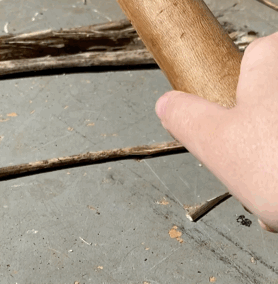
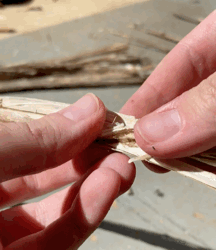
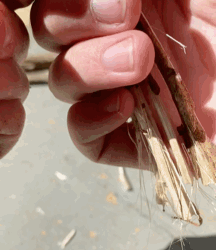
breaking open dried milkweed stalks to collect their bast fibers.
i pounded them with a makeshift billet against a smooth surface to break them similar to how ive broken brambles before, and then snapped the pith in order to get only the outer fibers.
At this point i had a bunch of the papery skins attaching all the fibers together, like the image just below. But peeling them off is both inefficient and can lead to breaking

in order to get rid of the outer layer, i rubbed/rolled them vigorously between the palms of my hands, breaking it into flakes that either fell off or can be combed/carded out. it was too difficult to film but basically the same as making a friction fire (although easier for sure).
At this point i had a handful of fibers, still long but in need of combing. I have a fine-toothed comb i use for a lot of fiber stuff, and ran that through it
I'll leave the sound on this one because it's an interesting auditory experience, some might like it some might hate it. Note, be prepared to sweep afterwards!
i used to worry about combing stuff like this too much, and i sort of still am, but its important to remember that what im removing are fibers that would otherwise be too short or fragile to include in a refined long-fiber bundle. What im going for is a line flax/fluff flax-like combo; aka i comb out the short fibers and then i have a bundle of extra long ones to work with!

the result is two bundles of different textures and potential
i made a little test string with the "line" milkweed, but i have yet to do anything more with it

as for the fluff, i carded it out!

i made it into a rolag that i then spun up on my tiny spindle
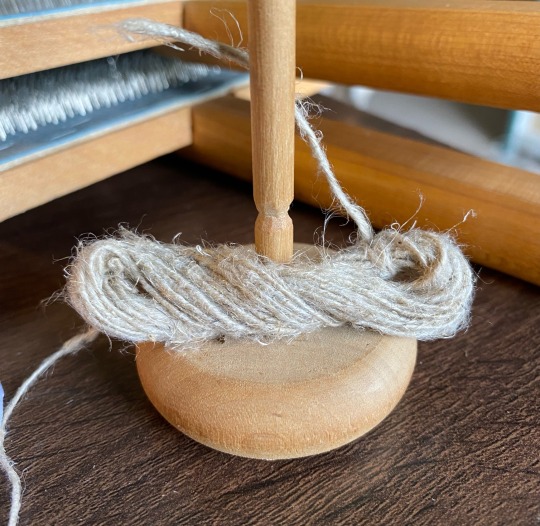
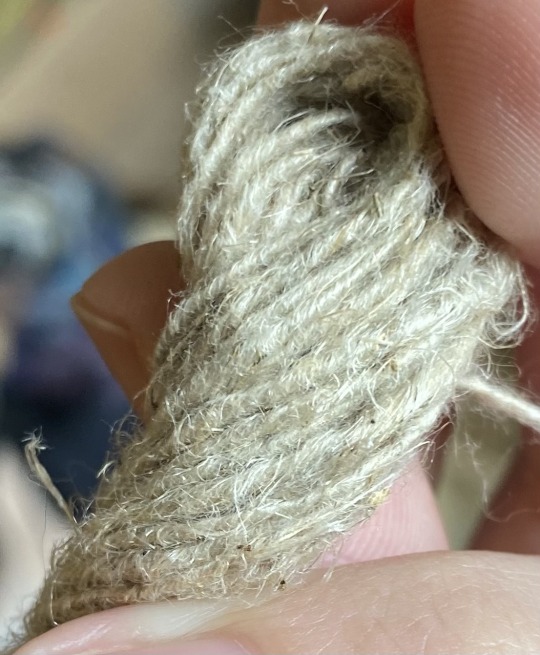
I quite like it. It definitely reminds me of flax/linen, which makes sense since it's also a bast fiber. Milkweed is often known for being extremely strong; i've heard from a fiber class instructor that you can tow a car with a finger-sized rope of it
I don't know exactly what kind of milkweed this is , but i've heard swamp milkweed is top of the class for fiber. orange butterflyweed is a bit weaker than this one (which might be swamp, might not)
(Also note, if you plant milkweeds, don't plant tropical milkweed outside of its native range! it's not as good as the native ones and can even increase disease in monarchs since it doesnt die back in warm winters)

anyways, have a lil monarch caterpillar!
#crafts#fiber arts#cordage#natural fibers#milkweed#bast fibers#nature#earth skills#drop spindle#handspinning
5K notes
·
View notes
Text


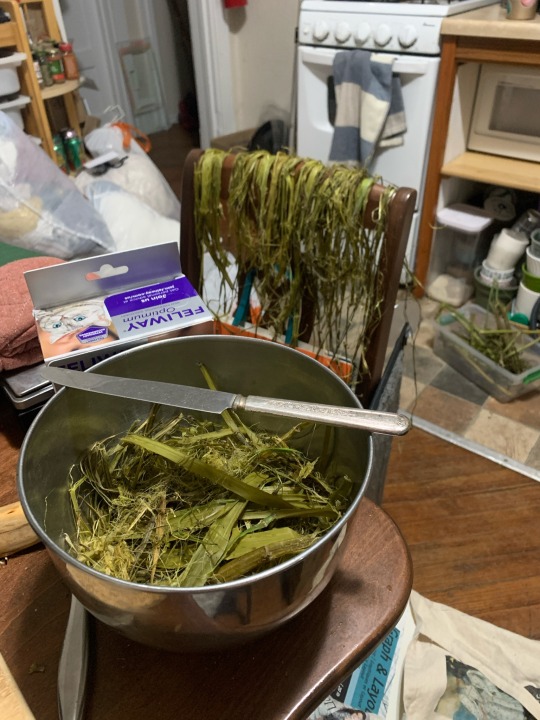
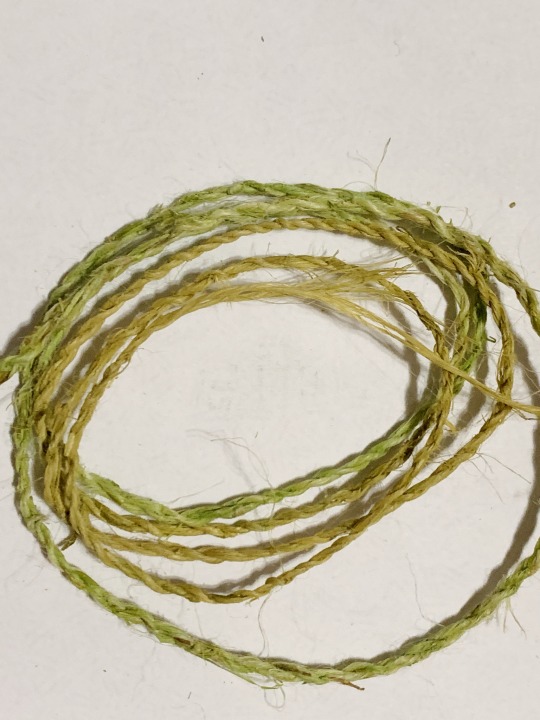
I am processing nettle to do various fiber craft experiments with and you may notice the terrible stock pot situation which resulted in me setting a towel on fire briefly but hey. I have successfully made nettle cordage. The difference in color is dependent on how much I scraped and cleaned the fiber before use!
Unfortunately the journey is far from over and I expect I shall be in nettle hell for weeks to come
Other nettle projects include spinning, papermaking, dyeing (root and leaf) and eating. I have already eaten it but I think the season is wrong. Not much taste only texture. anyways! Good times and also suffering
#but I voluntarily wanted to do this I’m so excited about nettle as a plant tbh#art#nettle#fiber crafts#cordage#fiber art#textiles#my art#mine#cyanoupdates#I would like to one day do a performance piece? art experience??? of recreating the stipulations in the fairy tale#where you must gather the nettle by hand#dance upon it barefoot#card and spin the fiber and then weave it into shirts#all while remaining silent#not all of this I think I would stop once I got to spinning#but I would like to try it#to understand the suffering#you know?#embodiment something something
150 notes
·
View notes
Text
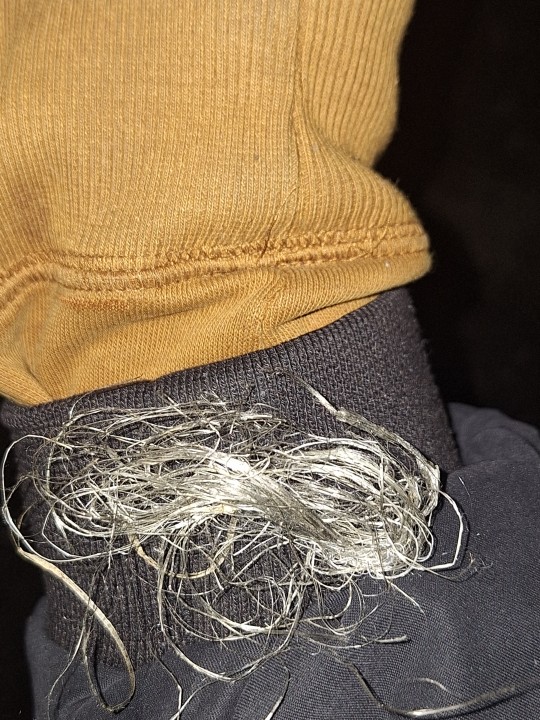
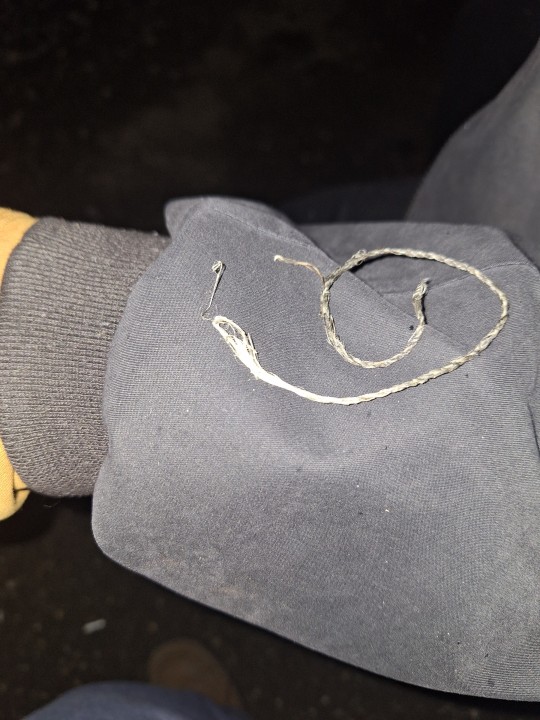
Crossed by my milkweed patch on the way to the pie shop and grabbed a rotting stalk and quickly pulled it apart by hand. And then twisted into 2 ply cordage. Not the prettiest but I like it.
Credit to purples shoe. Also to taking the picture for me 💜



#milkweed#cordage#bast fiber#wish i had grabbed more#but i also literally have like 50 stalks on my porch#and its too cold to process them.mm#also was very high and its dark#we dont need to talk about where i put the rotting plant material in my mouth to smooth it.
56 notes
·
View notes
Text

Attrape lune…
#photography#original photography#nature#corsedusud#original photography on tumblr#lune#bouée#cordage#ciel bleu
36 notes
·
View notes
Text
@/foragedfibres on Instagram
#v#handicraft#cordage#weaving#crafts#herbarium#corn#zero waste#low waste#corn husks#herbalism#Zea mays
108 notes
·
View notes
Text
You ever feel a hyperfixation coming on like a cold?
The way you start to notice a tickle in your throat or that the room is too warm for no reason, except it's how you didn't need to eat while doing that craft for four hours, or how your heart goes pitter-pat when you hear the theme music from that TV show.
Anyway, put yours in tags.
18 notes
·
View notes
Photo
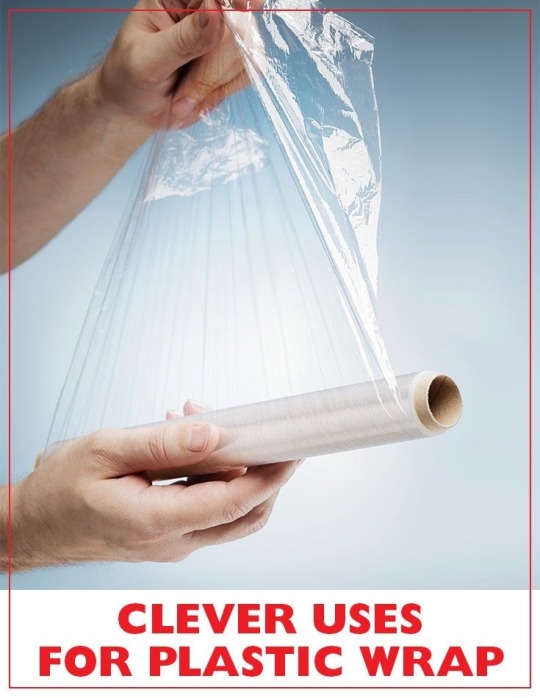
Clever and Survival Uses for Plastic Wrap/Sheeting:
Many everyday objects around the house are helpful for prepping, survival and alternative purposes for which they were not intended. One such ordinary household item is plastic wrap. From kitchen wrap to stretch wrap ("clinging" or "stretching" properties) or heavier plastic sheeting, there are an incredible number of uses. Use your imagination. Always have a roll nearby.
Keep air and moisture out and body heat in by wrapping torso, limbs and feet to preserve body heat and stay dry
Collect rain
Build a Solar Still
Shelter - Covering to make a temporary rain-proof shelter or cover an existing shelter
Water container - Fashion a makeshift container to hold water
Fire starter - Use the makeshift water container to act as a magnifying glass or light it with a match as an accelerant
Waterproof gear
Cordage - TWISTING plastic wrap into a rope makes it extremely strong.
First Aid - cover a wound, make a sling or tourniquet
Ground covering from wet and cold
Winterizing Windows and Doors
Signalling for help or trail marking - it's fairly reflective to attract attention.
Vehicle hose repair
Tool Handle Grip - tool that feels slippery; wrap plastic wrap around the handle of the tool a few times for better grip.
Wrap the ends of your bananas in plastic wrap to slow down the ripening process
Keep items together and in place by placing and wrapping them in a sheet of wrap
Ice cream freezer burn prevention - cover the surface of the ice cream
Shelf liner
Cover to protect surfaces from spills
Cover to protect electronic devices
Covers for open containers
Prevent mixing splatters by covering the mixing container while mixing
Make a travel cup out of any container - cover opening with wrap and stick drinking straw through it
Cover liquid containers under lids to prevent spills and evaporation
Wrap paint rollers and brushes to keep them from drying out between uses.
Wrap Gifts in lots of Plastic Wrap For A Good Laugh
Line dishes with plastic wrap for easy cleanup. Throw away the plastic wrap when the food is over.
Fruit Fly Trap - Puncture small holes in a cover over a small saucer or container containing vinegar or fruit to attract and trap them.
Resources: [Article 1] [Article 2] [Article 3] [Article 4] [Images]
[Reference Link]
[14-Point Emergency Preps Checklist]
[11-Cs Basic Emergency Kit]
[Learn to be More Self-Sufficient]
[The Ultimate Preparation]
[5six7 Menu]
#plasticWrap#plasticSheetingUses#prepper#survival#shtf#diy#redneck#covering#cordage#firstAid#water#prepare4tomorrow#5six7
28 notes
·
View notes
Text
Basketry: Take two
So if you remember, a few days ago I attempted to make a basket out of unprocessed, unknown type of bush/tree, and it was fun! It didn’t produce a basket, but I got some practical knowledge.
Since then, I’ve started following a lot of basketry groups and blogs, and the things I’ve learned have made me impressed and intrigued. Firstly, these people have no limits in what they’ll make a basket of; trees, grasses, dry stems of plants, houseplants, dry corn leaves, wild brambles, tree bark, vines, you name it; they’ve made a basket out of it. Secondly, they’re not just making natural baskets, but cordage, out of almost every natural material! They know how to process stems of cattails and all kinds of plants in order to get the fibers and make them into little cords, and then they can even use those cords for making baskets! And the cords can be used for anything you would need a piece of string, like macrame, crafts, tying up plants, it’s incredible!
So now I’m determined to get more of this knowledge, it seems almost godly to be able to go out in the wild and then create practical items out of every piece of grass, stem and tree.
One vital piece of information I’ve gathered, is that you can harvest blackberry bramble using thick gloves and shears, and then you run it thru a piece of old denim in order to scrub all of the thorns from it, and it’s usable for basketry. This information feels golden, because not only is blackberry is perfectly pliable and easy to manipulate in basketry, but it’s invasive and overgrowing the entire field I work on, so making it usable for practical purposes is a dream come true. I will be testing this out today!
So I’m at it again; I’m out and first thing I want to do is collect that same non-identified tree/bush branches in order to try and complete my failed basket. I’m smarter this time, so I’ll be collecting only the thinnest and most pliable branches!
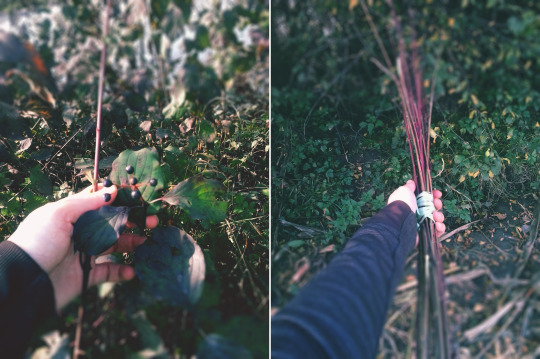
This is how that bush thing looks like, it even has some black berries, which makes me believe it’s a rhamnus (Buckthorn). Anyway, I got a bunch of it, and then went to look for the blackberry brambles.

I found this grass situation on the way, and figured that if everything else fails, I can always try to make some grass stuff? Grass has to be easy to weave with, it’s extremely pliant. The only thing is, this grass’ edge is very sharp. It gave me a papercut almost immediately. Still, I got a bunch. Maybe it won’t matter that it’s sharp.
Okay, so I arrived at the blackberry place, and I have my very thick gloves on, and I’ll try running the vines thru a piece of old denim, to see if it really removes all those thorns:
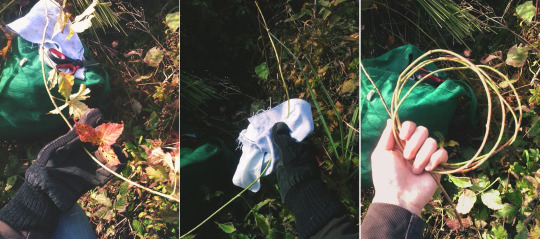
Not only it worked, it worked immediately and perfectly! I was careful to run it in both directions, but even after running it once, the brambles have been smooth and safe to handle! I was able to hold it in my hand! I’m extremely pleased, and I spent next 15 minutes pulling out the invasive blackberries, and making good material out of them:

My piece of denim is a bit filthy, but it isn’t badly damaged! It will be good for more times.
So, I got home, put all that stuff on the floor, and figured I should go see if I can re-do my last basket. It’s been on my balcony ever since, drawing the attention and sympathy of the onlookers. Here’s what I got:
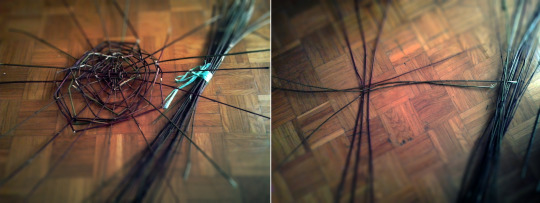
Since the spines of the last basket were essentially fine, I tore off all of the branches I attempted to weave with the last time, and decided to start again, this time with a bit thinner ones!
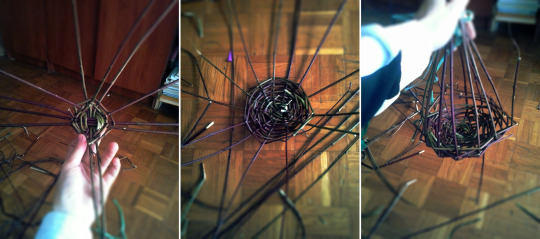
And it started off great! Mind you, I was still using a LOT of brute force here, these branches did not want to bend the way I wanted them to, I was being pretty aggressive to make it look like this. The start looks awesome, and then I realized that bending the basket to go up, is not as easy as it was with newspapers, and I struggled a bit to make the bend and to continue weaving upwards.
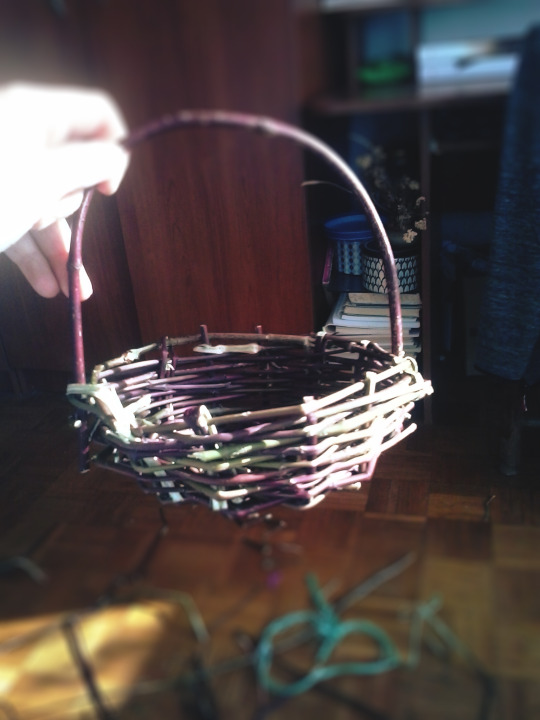
And here’s a basket! As you can see, I didn’t end it very professionally, I just cut off the ribs and pushed in the handle (it’s not safely inside, it could detach with weight), but this, this is definitely a basket-shaped item! Compared to the last thing I did, this is a good learning curve in the working.
Now, sadly, this basket is barely usable, or more specifically, it’s usable only for the stuff that doesn’t mind being stabbed. Since the material was so hard to bend, when I wanted to put in a new branch, I had to stab it into the basket, and force it into any opening available; I couldn’t tuck it down nicely as you’re supposed to. So at the end, I had to cut a whole lot of branch endings, and the sharp edges have remained everywhere; you can get stabbed just by holding this thing.
Not to despair, this is a learning basket, and now I know there’s a problem like that, I can work on it! I filled that basket with walnuts and pinecones and I’m perfectly happy with how it looks right now.
This basket will also show me how this material stands the test of time; when raw materials like this dry, they usually shrink up, so the basket might lose a bit of it’s shape, and I will see in few months what it looks like.
I still have blackberry bramble, some drying dandelion stems, twine, and my grass, but I did tire myself out making this, so I’ll leave those for another day. And when some of these materials manage to dry, I will try doing the proper process of drying and soaking, to see what difference does it make to use raw vs prepared material. But this is what the raw thing can do! I’m happy to know it.
#basketry#learning#diy basket#weaving baskets#foraging for wild materials#cordage#blackberry bramble#btw if you're going out to collect blackberry bramble#take the leaves too#they're medicinal and make good tasting tea!#tea tastes fruity#and its anti-diarrhea medicine
54 notes
·
View notes
Photo




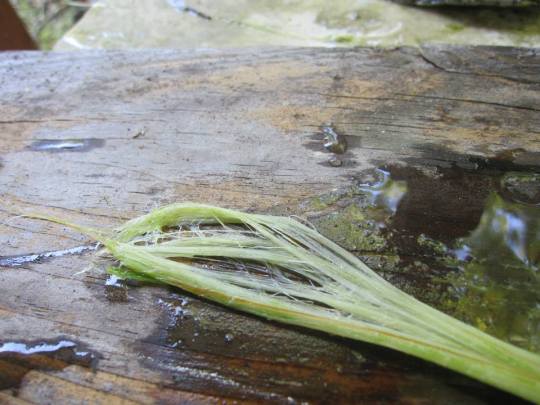
Yucca fibers are a bit laborious to process, but not especially difficult, and it makes lovely cordage. First you pound it with a rock or something to loosen the pulp from the fibers. Just make sure whatever you use is blunt; you don’t want to sever the fibers. Then you use something like a spoon, bone, shell, etc. to gently scrape the pulp off the fibers, a little bit at a time. Rinse the fibers in water every couple minutes. Keep scraping and rinsing until it looks clean, and kinda flax-like, as in the last photo, and it’s ready to twist into cordage!
22 notes
·
View notes
Text
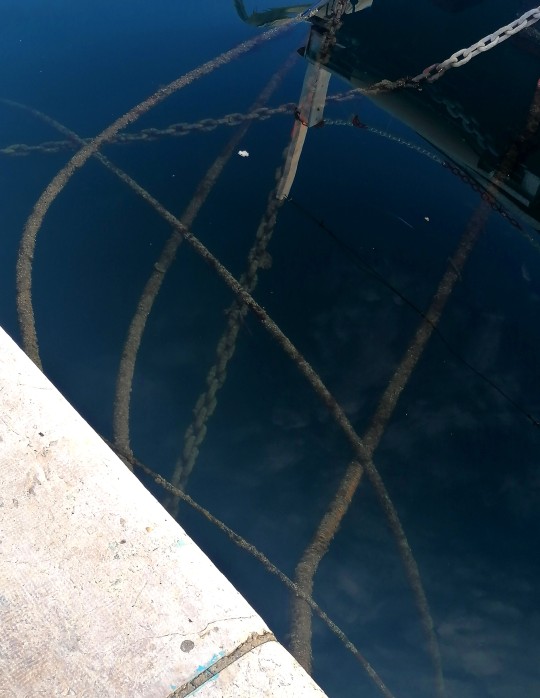
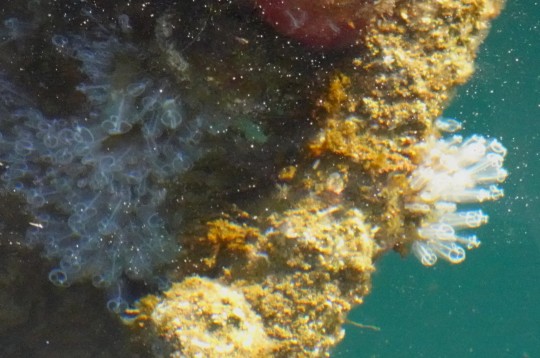




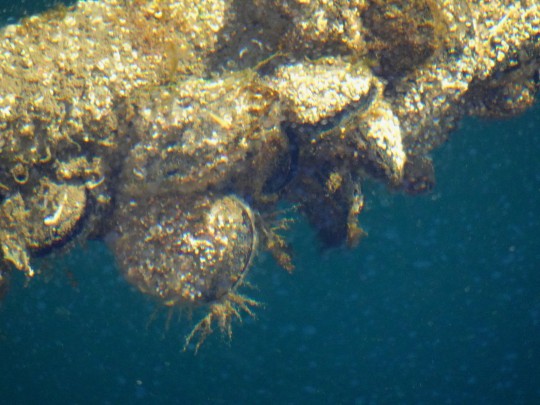

Marseille. Sous les eaux du Vieux-Port. Des chaînes, des moules (?) et des ascidies blanches (??? Si qqun peut m'éclairer à leur sujet?).
Et un superbe vélo "à louer" !!!
PS : Après recherches, j'ai trouvé le nom de ces tubes blanchâtres. Ce sont bien des Ascidies, plus précisément des Clavellines. Reste à savoir si les mollusques plats sont bien des moules ?
#marseille#vieux-port#transparence#chaîne#cordage#corde#moule#huître#ascidie#vélo#concrétions#clavelline
3 notes
·
View notes
Text
Ok quick post but heres a closeup of the "good" milkweed barks ive gotten just now and the "bad" milkweed barks. the good ones were from the larger mystery species and the smaller ones were poorer quality. I do want to try retting the poor quality ones still but you can tell the good ones are easily separated once dry. Theyre also beautifully shiny
Anyways enjoy!
(the first one is the best batch, the second one is the bad/inseparable batch)
to get them to that point i just cracked them lengthwise back and forth (using pliers this time since i dont feel like aggravating my back on the floor) and then snapped them off like normal
29 notes
·
View notes
Text
My dandelion cordage is holding up on my hoya beautifully! And the cut end doesn't even want to unravel as of now which was a suprise. I'm thinking on a basket to store my trinkets in, tried once without any box to go around the gave up immidiately, dandelion was definitely too soft as spokes for a freeform basket. At least for a total noob like me


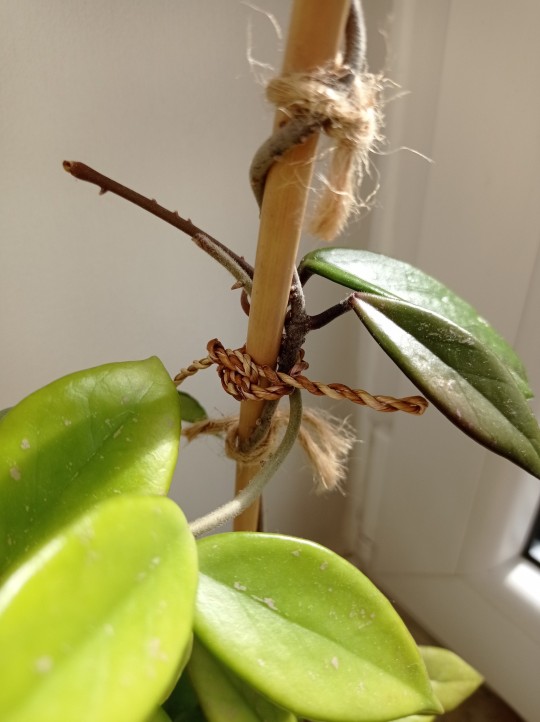
3 notes
·
View notes
Text




Hiieee I did my hair today and I really liked it so I put STUFF in it that I like! I tied a button necklace that I made around the left braid at the top, braided two very thin ceramic rings into the lower parts of my double braids, stuck an old jeans button and a pretty looking pin into my right braid and wrapped the braids with dandelion cordage I made myself :3 the cordage goes up and down around the braids twice and crosses over the top of my head to make something that looks like a hairband. I thought I should share this with the tumblrnet because weirdcore and stuff
#weirdcore#maximalism#sustainable maximalism#nonbinary hair#nonbinary#dirtcore#naturecore#cluttercore#cordage#ceramics#hairstyle#hair#genderqueer#GNC#elfcore#fairycore#plantkin#my photos#my face#art#my post
36 notes
·
View notes
Text
I learned how to make cordage and it's taken over my life.
Left to right we have cordage made from: plastic grocery bags, dandelion stems, and an old blanket!

2 notes
·
View notes
Text
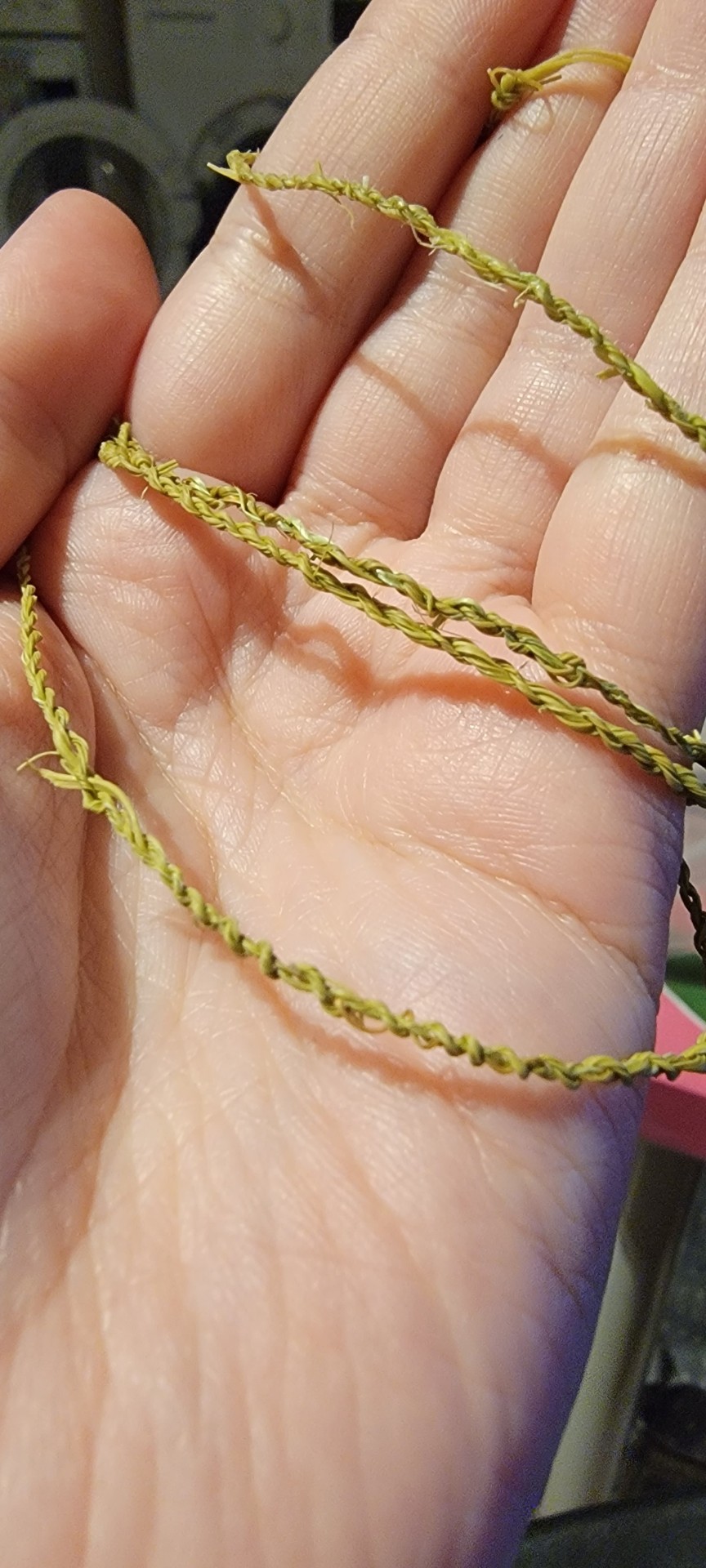
Cordage made from fibre of bracken.
2 notes
·
View notes
Text
turning a blackberry cane into twine was probably the single most autistic thing I did this week, lmfao
my "finished product" in the last pic is made out of scraps and is my 1st attempt so I expect future cords will look much nicer
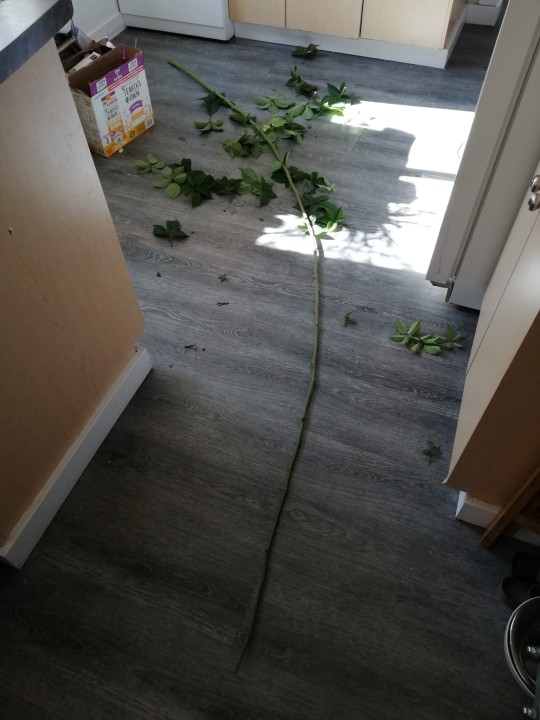
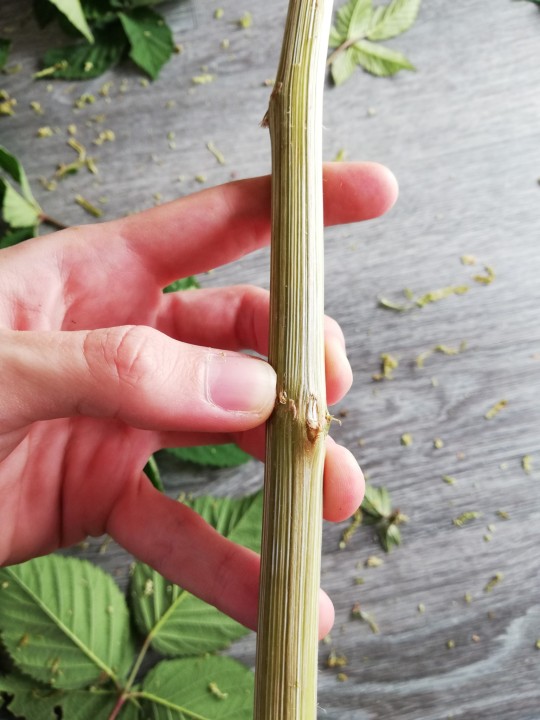



6 notes
·
View notes